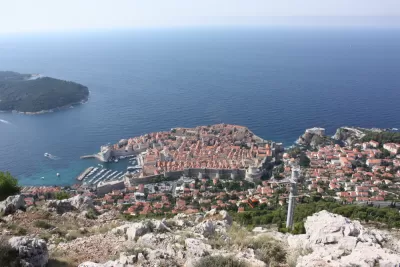Spoilers are coming.

Feargus O'Sullivan chimes in on the big question of the day: What are we to think of the fate of King's Landing?
Social media channels has been overwhelmed this week with discussion about the events in the penultimate episode of Game of Thrones, aired last week, ahead of the finale episode tonight, so it's only fair that someone finally found an urbanism angle to report.
O'Sullivan writes:
In the midst of the recent hullaballoo about “The Bells,” the penultimate episode of HBO’s Game of Thrones, something got missed in the confusion. The true star of the episode was neither a newly unsympathetic Daenerys nor her fire-breathing baby. The real focus was the city of King’s Landing itself, shown up close and in remarkable detail just at the moment when it, and its unlucky residents, were being scorched to smithereens.
According to O'Sullivan, The Bells presented Kings Landing with new detail, showing the city's "true extent" for the first time. What we see is a beautiful city, with reasonable comparisons to Dubrovnik, Valletta, Malta, Girona, and Istanbul. The effect is a "Pre-Ottoman Constantinople," according to Feargus.
All of those comparisons are familiar, however. The world learned in The Bells that Kings Landing might better described like Denmark in Shakespeare's Hamlet.
…King’s Landing may be impressive to look at, but it’s largely a miserable place to live in, and the world that created it is rotten.
This is a civilization that can construct buildings so impressive that they make soaring real-life medieval cathedrals look like shrubs in comparison. The streets beneath the citadels, however, are largely mean, dingy warrens so tightly packed with people that a jumping flea could travel the city’s circumference without ever leaving a body. In “The Bells,” incinerated spires crash from the sky and onto the terrified folk below—death by authoritarian architecture. Faced with a dragon, not even the city walls are much use to the people shown desperately trying to press through their gates to what they think is safety.
Such dichotomous realities are familiar in the real world, notes O'Sullivan, including some of the cities listed above.
FULL STORY: King’s Landing Was Always a Miserable Dump

Trump Administration Could Effectively End Housing Voucher Program
Federal officials are eyeing major cuts to the Section 8 program that helps millions of low-income households pay rent.

Planetizen Federal Action Tracker
A weekly monitor of how Trump’s orders and actions are impacting planners and planning in America.

Ken Jennings Launches Transit Web Series
The Jeopardy champ wants you to ride public transit.

How Project Connect Would Change ‘The Drag’
A popular — and sometimes deadly — Austin road will exchange car lanes for light rail.

Milwaukee Road to Get Complete Streets Upgrades
The city will reduce vehicle lanes and build a protected multi-use trail including bioswales and other water retention features on its ‘secret highway.’

Tackling Soil Contamination With Nature-Based Solutions
Los Angeles County residents and experts are turning to nature-based methods like bioremediation to address long-standing and fire-exacerbated soil contamination without resorting to costly and disruptive removal.
Urban Design for Planners 1: Software Tools
This six-course series explores essential urban design concepts using open source software and equips planners with the tools they need to participate fully in the urban design process.
Planning for Universal Design
Learn the tools for implementing Universal Design in planning regulations.
Ada County Highway District
Clanton & Associates, Inc.
Jessamine County Fiscal Court
Institute for Housing and Urban Development Studies (IHS)
City of Grandview
Harvard GSD Executive Education
Toledo-Lucas County Plan Commissions
Salt Lake City
NYU Wagner Graduate School of Public Service



























